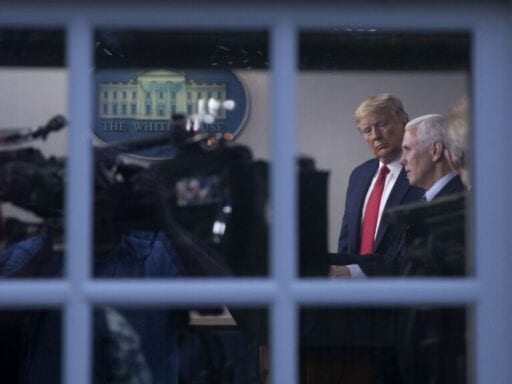New data suggests Trump’s early virus denialism changed the way his supporters thought about their personal response to the pandemic.
As the coronavirus pandemic took hold in late February and early March, President Trump and his allies in the conservative media adopted a skeptical tone. Trump said that “one day, it’s like a miracle, it will disappear;” Fox Business host Trish Regan called it “yet another attempt to impeach the president.”
Some preliminary early data suggests that Trump and Fox downplaying the pandemic made Trump supporters less likely to take the disease seriously early on.
Brian Schaffner, a political scientist at Tufts University who studies public opinion and partisanship, used Google searches for hand sanitizer as a proxy measurement for how seriously people in a particular media market were taking the outbreak. The knowledge that hand sanitizer (like ordinary soap) fights coronavirus spread led concerned people to buy it in bulk early on, so areas where more people were looking for hand sanitizer could suggest the residents were more concerned about the disease’s spread.
The following animated chart from Schaffner shows a simple regression analysis comparing hand sanitizer searches since the beginning of March to the percentage of people in a given media market who voted for Trump. On March 1 through March 12, when Trump and Fox were still in denial, there was a heavy partisan lean: anti-Trump areas searching at much higher rates than pro-Trump ones.
But on March 13, Trump declared a national emergency over coronavirus, and, afterward, started taking the virus more seriously in public rhetoric and response. And starting on March 13, the partisan tilt disappears:
last cut at this. you can see pretty clearly how responses to Covid19 were quite partisan until Trump/Republicans/Fox News started taking it more seriously.
final code can be found here (incl. models controlling for covid19 cases): https://t.co/0a8oGpcoEw pic.twitter.com/NvpCYJSzLD
— Brian Schaffner (@b_schaffner) March 23, 2020
Here’s a non-moving version that also includes the entire year 2019, when there was no partisan lean, as a baseline:
here you can see static plots with a comparison to 2019. the latter two plots are split to show before and after Trump declared a national emergency pic.twitter.com/qEt7GYSDkE
— Brian Schaffner (@b_schaffner) March 23, 2020
Schaffner’s research here is very preliminary. It’s worth noting that there are several possible confounding variables, including the fact that some of the hardest-hit earlier states were blue-leaning coastal ones like Washington, California, and New York.
But his findings are consistent with early polling on coronavirus showing the same partisan gap, with Democrats consistently saying they were more likely to take individual action on coronavirus than Republicans.
It also fits with what we’ve observed more broadly during the Trump administration: The president’s stance on something causes Republicans to align with it and Democrats to oppose it, as well as a large, pre-Trump body of research on public opinion suggesting that voters often take cues on complex policy issues from trusted elites. For Democrats during coronavirus, those experts were the mainstream media and public health experts; for Republicans, it was Trump and Fox News.
The result is what looks like an early partisan response, where Democrats started to change their behavior to prevent the virus’s spread while Republicans, convinced the entire thing was ginned up to hurt Trump, did not.
Further research will need to be done to show that this was, in fact, what happened. But as evidence continues to mount for a partisan gap in coronavirus response early on, we should take seriously the possibility that Trump returning to downplaying the risks of the virus would also lead to a vast swath of the American public ignoring public health advice — and thus contributing to the pandemic’s rapid spread.
Given that the president sent out an all-caps tweet last night about reopening businesses, it’s a risk worth taking seriously.
Author: Zack Beauchamp
Read More



